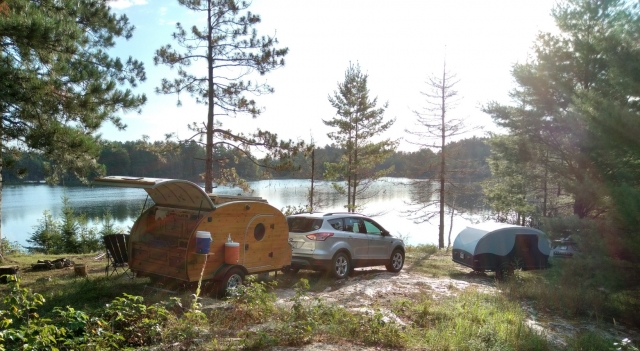ultra lightweight trailer chassis concept
29 posts
• Page 1 of 2 • 1, 2
ultra lightweight trailer chassis concept
This build (design exercise really, since it will be awhile before I can get to the actual build) will be done in two threads -- one for the teardrop and one for the chassis. The teardrop thread is here: https://www.tnttt.com/viewtopic.php?f=27&t=75601. In order to lower the overall weight of the build, it became apparent that none of the commercially available trailers would work due to the weight. Furthermore, bolt-together trailers will generally be heavier than one that is designed and purpose-built. This chassis will cover what is necessary to size a trailer chassis with a couple of caveats: 1) the teardrop body will be designed as a mostly self-supporting structure 2) the sizing assumes that the trailer is not poorly loaded, or overloaded. I'll discuss the options, and design choices, and explain the fundamentals of how the chassis sizing can be done by anyone who can follow the math and punch the numbers into their calculator. With patience, I don't think it is terribly difficult once it's laid out and I will be happy to answer questions. I will also touch briefly on fatigue (that won't be too deep as I'm not a fatigue specialist).
General trailer layout:
Most trailers are very overbuilt and don't consider the strength brought to the table by the teardrop cabin. Therefore much of the trailer chassis is just along for the ride -- adding weight, but not doing much of anything -- I'm gonna throw that junk away! The walls of the cabin are extremely stiff -- far stiffer even than the steal frame and we're going to take advantage of that. The overall layout will take into account the stiffness of the cabin, which means that the trailer chassis itself can be greatly reduced! You might even call it a reduced chassis or a partial chassis. It's just enough to support the the load introduction from the chassis to the cabin. The cabin will take care of the cabin (we don't need no stinking chassis! (not entirely true, but you get the point!))
The chassis width is 48 inches
Aluminum is 1/3 the weight of steel. I've used steel in airplanes, but when we use it in aerospace -- it's the good stuff. I cant afford the good stuff, so lets compare hobbyist grade aluminum to mild steel:
Steel - mild steel
Yield stress = 47.7 Ksi
Ultimate stress = 58 Ksi
Aluminum 6061-T6
Yield stress = Fcy = 37 Ksi
Ultimate stress = Ftu = 41 Ksi
Aluminum 6061-T4 (T6 post weld and age hardened is approximately T4)
Yield stress = Fcy = 16 Ksi
Ultimate stress = Ftu = 26 Ksi
So, although there are stronger aluminums (more expensive), and stronger steels (more expensive), at the bottom we see that the mild steel is a little stronger than the common 6061-T6 aluminum that the consumer is likely to have access to; however, it is 3 times the weight! A quick check at On-line Metals shows for a 6 ft piece of .065 1x2 steel the price is $36.71, while the same 6061-T6 aluminum in .062 wall is 32.50! So, at the same price, 1/3 the weight and nearly the same strength - let's investigate the aluminum.
General trailer layout:
Most trailers are very overbuilt and don't consider the strength brought to the table by the teardrop cabin. Therefore much of the trailer chassis is just along for the ride -- adding weight, but not doing much of anything -- I'm gonna throw that junk away! The walls of the cabin are extremely stiff -- far stiffer even than the steal frame and we're going to take advantage of that. The overall layout will take into account the stiffness of the cabin, which means that the trailer chassis itself can be greatly reduced! You might even call it a reduced chassis or a partial chassis. It's just enough to support the the load introduction from the chassis to the cabin. The cabin will take care of the cabin (we don't need no stinking chassis! (not entirely true, but you get the point!))
The chassis width is 48 inches
Aluminum is 1/3 the weight of steel. I've used steel in airplanes, but when we use it in aerospace -- it's the good stuff. I cant afford the good stuff, so lets compare hobbyist grade aluminum to mild steel:
Steel - mild steel
Yield stress = 47.7 Ksi
Ultimate stress = 58 Ksi
Aluminum 6061-T6
Yield stress = Fcy = 37 Ksi
Ultimate stress = Ftu = 41 Ksi
Aluminum 6061-T4 (T6 post weld and age hardened is approximately T4)
Yield stress = Fcy = 16 Ksi
Ultimate stress = Ftu = 26 Ksi
So, although there are stronger aluminums (more expensive), and stronger steels (more expensive), at the bottom we see that the mild steel is a little stronger than the common 6061-T6 aluminum that the consumer is likely to have access to; however, it is 3 times the weight! A quick check at On-line Metals shows for a 6 ft piece of .065 1x2 steel the price is $36.71, while the same 6061-T6 aluminum in .062 wall is 32.50! So, at the same price, 1/3 the weight and nearly the same strength - let's investigate the aluminum.
-

kennyrayandersen - 1000 Club

- Posts: 1750
- Images: 38
- Joined: Sun Apr 29, 2007 10:27 pm
- Location: TX
Re: ultra lightweight trailer chassis concept
I like this design. I'll be watching closely.
I want to create an ultralight teardrop that my EV can pull without seriously limiting its range. I have an old boat trailer (4' wide between wheels/fenders) and I was going to convert that but maybe I'll use its axle and go this route instead. Anxious to hear from the engineer types to see the precautions of a chassis like this.
Tim
I want to create an ultralight teardrop that my EV can pull without seriously limiting its range. I have an old boat trailer (4' wide between wheels/fenders) and I was going to convert that but maybe I'll use its axle and go this route instead. Anxious to hear from the engineer types to see the precautions of a chassis like this.
Tim
Tim
Niagara, WI
My First Benroy Teardrop Build Thread - A 5x8 Woodie - http://www.tnttt.com/viewtopic.php?f=50&t=63575
My Second Teardrop (partial) Build Thread - Started August '16 - http://www.tnttt.com/viewtopic.php?f=50&t=66939
#3 My son's Benroy Foamie team build - Started July '20 - http://www.tnttt.com/viewtopic.php?f=50&t=72877

Niagara, WI
My First Benroy Teardrop Build Thread - A 5x8 Woodie - http://www.tnttt.com/viewtopic.php?f=50&t=63575
My Second Teardrop (partial) Build Thread - Started August '16 - http://www.tnttt.com/viewtopic.php?f=50&t=66939
#3 My son's Benroy Foamie team build - Started July '20 - http://www.tnttt.com/viewtopic.php?f=50&t=72877
-

TimC - Gold Donating Member
- Posts: 1371
- Images: 733
- Joined: Sat May 23, 2015 4:15 am
- Location: WI/MI border


 But this is actually a very good suggestion. However, after having run the numbers a bit, I'm pretty confident that the trailer can be made from aluminum and we wouldn't want to put any welds, or unnecessary holes in the trailer frame, so attaching that member on the trailer would pose some design challenges. With aluminum -- especially heat-treated aluminum -- we don't want to introduce any unnecessary stress concentrations (Kt) because it would cause fatigue issues, or welds in critical areas as you lose the heat-treated strength in the weld zone. Calculations to follow!
But this is actually a very good suggestion. However, after having run the numbers a bit, I'm pretty confident that the trailer can be made from aluminum and we wouldn't want to put any welds, or unnecessary holes in the trailer frame, so attaching that member on the trailer would pose some design challenges. With aluminum -- especially heat-treated aluminum -- we don't want to introduce any unnecessary stress concentrations (Kt) because it would cause fatigue issues, or welds in critical areas as you lose the heat-treated strength in the weld zone. Calculations to follow!